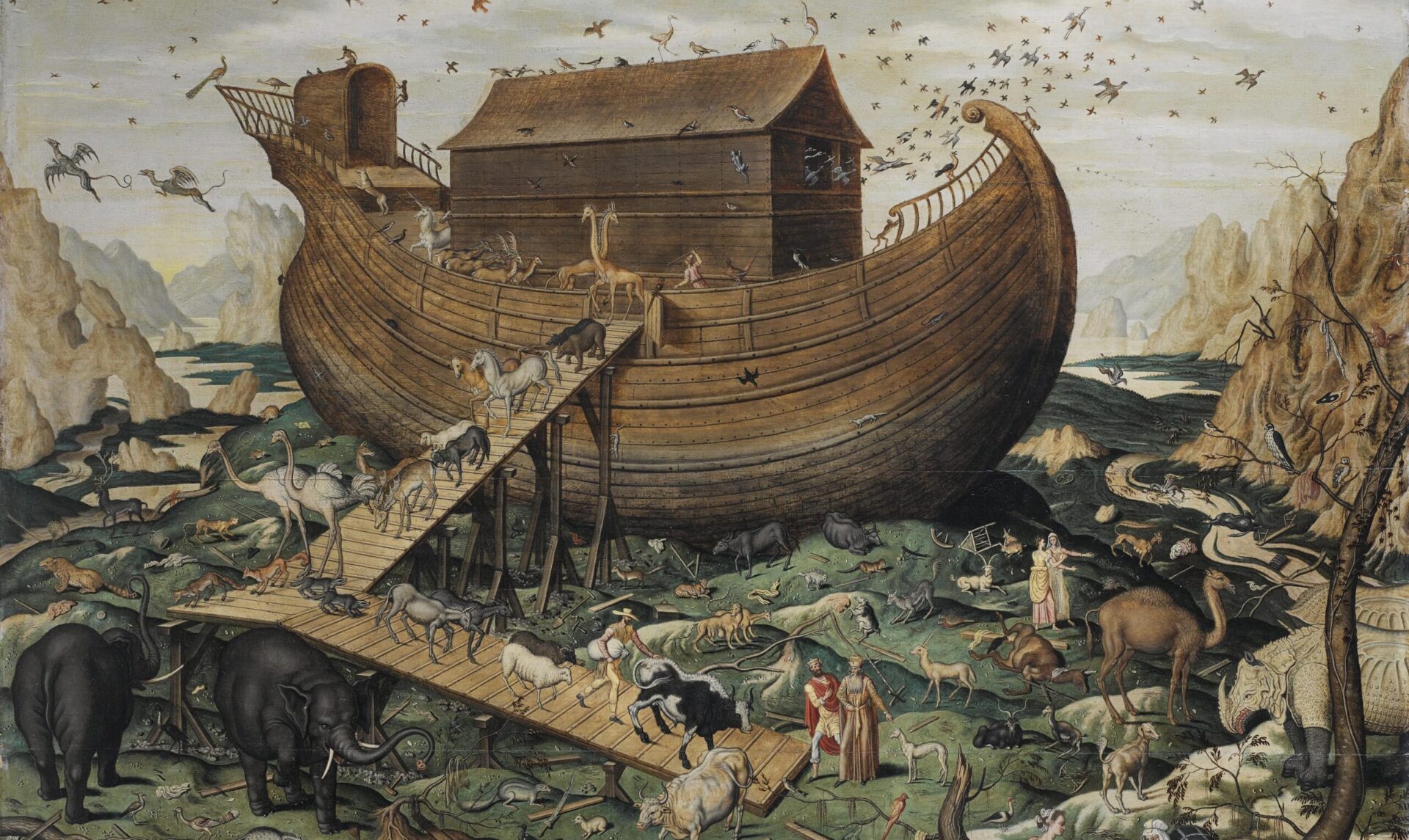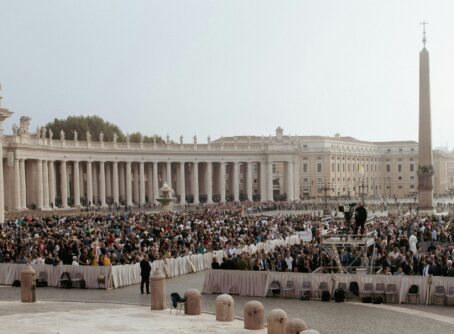
As part of our family culture, we revisit the Lenten devotional Wild Hope: Stories for Lent from the Vanishing by Gayle Boss each year with our young children. This devotional unfurls the stories of animals on the brink, threatened by mounting negative impacts on their environments. In her introduction, Boss writes about her struggle to fully engage her own young children’s imaginations and hearts in the Lenten season. One approach resonated more than others. She recounts:
“I learned that for centuries the church had pointed to Noah’s Ark as a symbol for ‘our Lenten passage.’…Next, the spiritual application: Noah’s story is our story, I told the boys. The ark is the church, the community that carries us across the roiling chaos of our lives—personal troubles and public troubles.”
Yet, her young sons lost interest when she emphasized the ark itself. What captivated them were “the ark’s screeching, leaping, hissing, slithering animals.”
Boss invites readers to wake up to “the amazingness of our arkmates,” which, she argues, “routes us directly to the heart of Lent.” While her emphasis on non-human creatures may or may not resonate with all Christians, I find her reflection on her children’s response deeply revealing—not just of childhood attention spans but of something truer about human nature, especially in our late-modern age.
As Boss reminds us, the ark is a symbol of the Church, not just a place of worship but a sacred institution conceived in the Holy Spirit and birthed at Pentecost. It is more than a collection of individuals; it is a structure through which Christ’s followers embody the beatitudinal call: to tend the poor, to grieve with mourners, to be the peacemakers, and extend mercy.
And yet, just as Boss’s sons were unmoved by the ark itself, preferring the drama of individual animals, we, too, are often captivated by personal stories rather than the stories of institutions: sacred structures that sustain us. Our cultural imagination celebrates the lone figure overcoming adversity—whether an endangered animal or a self-sufficient hero—while dismissing the institutions that enable interdependent care. But this is a myth. Neither humans nor animals survive alone.
We are living in a moment of another vanishing—not of species, but of sacred-centered communities institutions—Christian social services, housing ministries, nutritional support programs, behavioral health initiatives, civic groups, hospitals, and educational co-ops. Late-modern society does not tell stories about institutions. Our attention drifts toward individuals, much as Boss’ sons cared more about the animals than the ark. But Jesus’ parables never presented faith in isolation. His stories—filled with vineyards, banquets, houses built on rock—were not just about personal transformation; they depicted a world where spiritual and physical restoration happened within sacred structures—the various communities of purpose—that God gave us to live out the varied purposes of our lives.
Institutions as Communities of Shared, Sacred Purposes
For those who seek to both form and be formed by institutions with shared religious paradigms, this matters deeply. We live in a moment where our political communities, financial institutions, businesses, and media are viewed with deep skepticism due to the ways they perpetuate performative, rather than formative, roles. Our religious institutions are certainly not exempt from this. Every spiritually oriented group—from a congregational community to a social outreach ministry, from a homeschool co-op to a small group to a spiritually animated civic organization—must take seriously its role in engaging deeply with its members in the difficult but needed and God-given process of shaping and being shaped.
James Skillen writes in Step into My Office:
“In the broadest sense, “offices” are the varieties of duties and responsibilities to which God calls us with our diverse talents. Because this world is not in arbitrary chaos, its historical shape does not arise from us ex nihilo. We can only shape what the Creator gives us to shape. Families, schools, governments, and business enterprises take on particular shapes because everything that we do is a creaturely response to the multiple arenas of human accountability God created for us.”
We understand our role as creatures of God through bearing His image in everything we do. And that “everything we do” is not done on a blank canvas. It is done within the institutional structures through which we carry out His image: as parents and children in families, as workers in modern-day vineyards and fields, as givers of hospitality in our neighborhoods, as citizens in political communities, as advocates for the oppressed, and in so many other roles that have corresponding communities of purpose with shared norms, through which we participate in the interdependent and connected roles of individual and communal image-bearing.
When individuals engage in the process of carrying out the purposes for which a community or institution exists, the institution itself also shapes the individuals as they shape it.
The Decline of Religious Institutions and the Rise of the ‘Nones’
Pew Research Center’s recently released Religious Landscape Study, the first in 11 years, shows a steady erosion of Christian institutional life in the U.S that may now be leveling off. In 2007, 78% of American adults identified as some form of Christian. By 2014, that number had dropped to 71%, and in the most recent survey from 2023-24, only 62% of U.S. adults identified as Christian. Meanwhile, the religiously unaffiliated—the “nones,” representing those who are atheists, agnostics, and the spiritual but not religious (SBNR)—have grown to nearly 30% of the population.
However, Ryan Burge, in his recently released The American Religious Landscape: Facts, Trends, and the Future, warns that these unaffiliated individuals are not stepping in to build new institutions to replace the ones that are disappearing. As he writes:
“These ministries have been organized, funded, and implemented by people of faith with very little government oversight or support. In the future, these programs will begin to close, and there’s little evidence that points toward the growing number of nonreligious Americans being able to organize in a meaningful way to replace these types of social services for the local community.”
This institutional vacuum is not merely a logistical problem but a cultural and civic shift with long-term implications. The “nones” are not a monolithic group. Many are deeply spiritual, engaging in prayer, meditation, or other forms of highly individualized spiritual practices. The Fetzer Institute’s Study of Spirituality in the United States found that nearly half of respondents reported being part of a religious or spiritual community, but these communities remain largely tied to traditional religious institutions rather than independent spiritual gatherings. Moreover, four out of five spiritual-but-not-religious individuals are not formally affiliated with any religious or spiritual community at all.
While spiritual beliefs persist among most Americans, they are no longer embedded within the same kinds of intergenerational institutions that once shaped American religious and civic life. Religious institutions have historically provided both moral/spiritual formation and material relief—feeding the hungry, sheltering the homeless, providing counseling and education, and fostering civic engagement. The decline of these institutions does not necessarily mean that these services disappear immediately, but it does mean they become fragmented. Many of these social services—once a deeply embedded part of religious life—are now left to largely secular nonprofits that may not have the same depth of communal, spiritual, or moral formation at their core.
The Rise of Nonprofits—And the Limits of Secular Classification
At the same time that religious institutional affiliation has declined, the number of nonprofit organizations in the U.S. has grown significantly. Over the past decade alone, nonprofit formation has surged, rising from around 1.5 million organizations to nearly 2 million. However, it would be a mistake to assume that this growth is purely secular. Many of these new organizations may, in fact, be deeply shaped by religious or spiritual convictions—but the way nonprofits are classified makes this difficult to measure.
The National Taxonomy of Exempt Entities (NTEE) system, used by the IRS and research institutions to categorize nonprofit organizations, requires nonprofits to select a single category that best defines their mission. As a result, faith-based and other sacred-centered organizations that provide education, healthcare, housing, refugee resettlement, substance abuse treatment, or legal aid often categorize themselves under those specific service areas rather than under “Religion.” This means that many organizations whose core identity and operations are inseparable from their religious or spiritual mission are statistically invisible as faith-based organizations.
This categorization issue creates a misleading narrative. On one hand, it suggests a stark decline in faith-based organizations when, in reality, many religiously motivated nonprofits continue to operate but are statistically captured under other categories. On the other hand, it obscures the ways in which religious conviction remains a powerful force in social services and civic life. Many of these organizations are not simply nonprofits with religious values layered on top; their sacred source—their understanding of God’s calling—is the foundation that drives them to serve. Their primary mission is not just to provide social services but to honor God through service.
Institutional Longevity and the Danger of Fragmentation
Even though new nonprofits are emerging, they are not necessarily filling the deeper role of long-term religious institutions in providing sustained moral formation and community continuity. If social services become a patchwork of functionally secular nonprofits with limited life spans, something deeper is lost. The difference between an enduring religious institution and a time-limited nonprofit is not just about funding or logistics; it is about the cultural imagination that sustains them. Religious institutions are designed for generational continuity. They pass down traditions, ethics, and a shared sense of purpose over time. By contrast, many modern nonprofits operate on shorter time horizons—reliant on grant cycles, shifting donor priorities, and project-based funding that does not necessarily foster long-term communal formation, let alone spiritual nourishment and formation.
Jonathan Rauch, in his new book Cross Purposes: Christianity’s Broken Bargain with Democracy warns of the broader implications of this kind of institutional erosion:
“Without grace toward institutions and a story of how they can be improved and redeemed, nihilism, cynicism, and chaos are only a short step away—as January 6 made clear.”
Rauch’s argument suggests that institutions are more than functional entities; they provide stability, narrative continuity, and a shared framework, rooted in metaphysical values, for moral and civic life. When these institutions collapse without clear replacements, social fragmentation follows.
Sociologist Peter Berger, who once predicted a secularizing world, later rejected the idea of inevitable secularization. Instead, in his book Sacred Canopy: The Elements of a Sociological Theory of Religion forecasts the emergence of a new “sacred canopy.” Rather than a uniform decline in faith, he saw a pluralistic landscape where various religious and spiritual traditions – and the institutions that held those spiritually derived durable forms of meaning making – would reassert themselves in new forms.
This raises an urgent question: What kind of sacred canopy will emerge if Christian institutions continue to decline? If traditional religious institutions are eroding, what will take their place in shaping moral, spiritual, and civic life? The answer to this question will shape not only the future of American religion but also the future of American democracy, social cohesion, and the broader spiritual fabric of public life.
I would argue that we should not accept the decline of Christian institutions as an inevitability. Even as all faith-based organizations need to be responsive and open to shifting their forms and structures to meet the needs of this moment, I believe that Christian institutions offer a distinct, true spiritual worldview that cannot and should not diminish into obscurity but that is worth lifting up and restoring and advancing.
The secularizing influences of modernity have led many nonprofits to focus almost exclusively on meeting material needs while neglecting the deeper, integrated needs of the whole person. In a society that increasingly compartmentalizes religion into private belief rather than public life, the overarching cultural narrative has influenced the now dominant nonprofit model, which often approaches social services with a transactional mindset—providing food, shelter, or healthcare while leaving spiritual and moral formation untouched. Yet, faith-based nonprofits have long understood that human flourishing requires more than material provision; it requires a framework of meaning, hope, and relational belonging that only spiritually grounded institutions can provide. Without this, social services risk becoming fragmented, offering temporary relief without addressing the deeper spiritual brokenness that produces unfavorable material conditions. The decline of explicitly religious institutions in the nonprofit sector—and Christian nonprofits in particular—leaves a void that secular organizations are ill-equipped to fill.
This fragmentation of Christian social services is not just a problem for those who directly rely on them; it affects all who seek a holistic worldview that recognizes spiritual well-being as integral to human flourishing. Christian institutions, in particular, have historically provided both material and spiritual sustenance to the broader public, shaping the moral ecology of American life. As the largest religious tradition in the U.S., Christianity remains a central force for good in civic and social life, making its institutional decline a matter of national concern. A diverse religious landscape—one where Christian nonprofits coexist alongside other faith-based organizations—ensures that social services remain attuned to the profound, sacred dimensions of human need. Rather than retreating from public engagement, faith-based organizations must reclaim their role in forming individuals and communities toward a more integrated vision of service. If faith-based nonprofits fade or become indistinguishable from their secular counterparts, the loss will not just be for Christians—it will be for a society increasingly adrift, seeking meaning in institutions no longer equipped to provide it.
Chelsea Langston Bombino is a believer in sacred communities, a wife, and a mother. She serves as a program officer with the Fetzer Institute and a fellow with the Center for Public Justice.





